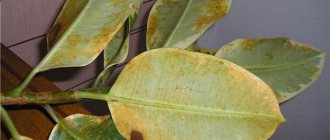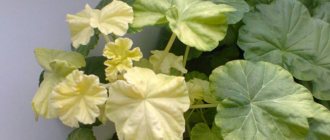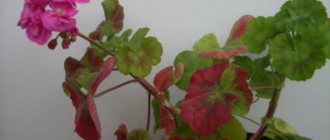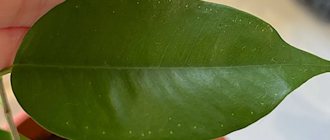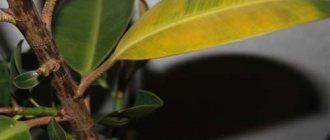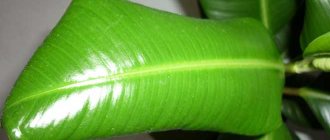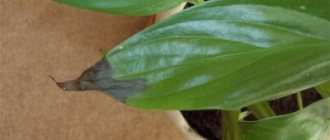Plants » Flowers
0
2347
Article rating
Kira Stoletova
When growing ficus plants at home, gardeners often encounter problems related to caring for home flowers. It is not uncommon for ficus leaves to fall off.
Causes of ficus leaves falling
The time is coming
For many ficus lovers, the period when the latter suddenly begins to shed its leaves comes as a complete surprise. They begin to look for the reasons that lead to the fact that the leaves turn red, darken to the color of rust, their tips turn inward, bend and deteriorate.
Thus, for the Benjamin (Impalce) flower and its curly variety Nitida, the slightest changes in the state of indoor comfort become the reason for the loss of leaves: a change in care methods, replanting, an attempt to propagate in winter or autumn.
Ficus, even with proper care, loses leaves every year; this is a natural process of changing leaves in winter. Falling occurs at the onset of the autumn-winter season. This is due to the aging of vegetation and the need for its renewal. Immediately with the arrival of cold weather, the leaves droop, become lethargic, turn yellow, curl and fall off. In winter, the leaves on the ficus fall off or do not dry out entirely, but only the lower ones, at the beginning of the trunk. With the onset of spring warmth, new and young ones will grow on the empty ficus trunk.
Reason #4. Light too bright or dim
As we have already mentioned, some ficus plants are exclusively shade-loving plants. Being suddenly exposed to direct sun or constantly being on the brightest windowsills, they will feel unwell, responding to this “attitude” towards themselves, including discoloration and drying out of the leaf blades, and even getting real sunburn.
Such plants include, for example, ficus sacred and ficus wall. The rubber ficus also adapts well to lighting.
But figs, ficus Benjamin, ficus lyreform, ficus microcarpa, rubber ficus, petiolate ficus, dwarf ficus, ficus binnendijka (willow leaf), on the contrary, love “stable” light places - but for them, light, even bright and plentiful, will be more acceptable, but scattered, not direct. In these species, on the contrary, it is excessive darkening that can cause the leaf blades to darken and fall off (usually starting from the lower ones).
- Ornamental plants for a shady balcony: list with photos Plants for shady places can be no less decorative and bright than light-loving crops.
Causes of leaf fall
If the ficus has dropped its leaves or they have drooped, withered, bent, curled up, turned yellow and brown, or fly off not only when the cold season sets in, the reasons lie in improper care: the home flower is missing something.
One of the most common reasons for leaf fall is a change in the climatic conditions in which the plant is accustomed to developing, which most often occurs during its propagation or transplantation.
Often, changing the location of a flower pot is a temporary phenomenon, so that a flower with curled leaf blades hangs down the foliage and then throws it off. In such a situation, it is quite possible to restore the former beautiful crown of the flower and root it before the leaves of the ficus fall off completely.
Among other reasons why ficus sheds its leaves, the most well-known in home floriculture are:
- excessive importance;
- sudden temperature changes and drafts,
- moving to new conditions immediately after transplantation,
- insufficient lighting,
- oversaturation of the soil layer with moisture,
- the presence of insectivorous parasites and fungal infections,
- soil contaminated with pesticides.
What to do to prevent leaves from falling off
To prevent leaf fall, you must follow the basic rules of plant care:
- Soil renewal. While the plant is small, it is necessary to periodically remove the top layer of soil and replace it with a new one. If the flower is large and the soil has never been renewed, it is necessary to gradually replace the old soil with new soil over 2 months so that the plant can receive all the necessary nutrients.
- Periodic fertilizing with biological fertilizers. To prevent soil depletion, flowers should be fertilized once every 2 weeks in the warm season.
- Crown formation. Trimming old and diseased leaves of Ficus Benjamin is necessary not only to give the plant a decorative appearance, but also to renew the ficus.
- Hygiene procedures. Once a month, you should wash the top and bottom leaves in the shower to prevent diseases and pests. During water procedures, it is important to ensure that excess water does not get into the pot.
- Shading. If the flower is installed in a place where the scorching sun hits it, light shading should be done. This procedure will help prevent leaf scorch. At the same time, it is important not to completely block the access of light to the plant.
- Timely treatment against parasites. To prevent the plant from weakening and dying, it should be treated against pests in a timely manner.
- Proper watering. Ficus plants should not be overwatered, and the soil should not be allowed to dry out. It is recommended to water when the top layers of soil dry out, with a small amount of warm, purified water.
It is important to remember that a healthy flower will not lose leaves without reason. If the crown begins to fall off, it means a mistake was made in the care. It is important to choose a permanent location for the flower and ensure constant humidity and temperature.
Regular monitoring of the condition of the plant will help to identify the problem in a timely manner, and prompt adoption of the correct ones will prevent serious problems in the condition of the flower. If you follow the rules of care, the ficus will delight you with its appearance for many years.
Diseases
Improper care can cause illness
In the list of common reasons why ficus trees shed leaves, the first number is emerging infections and care problems. In most cases they are easily removable. Measures taken in time make it possible to revive an indoor flower.
Avitaminosis
Lack of nutritional components in the soil where the ficus grows leads to shredding of the leaves. With inadequate feeding and improper care, when the indoor climate is too dry and the temperature is too high, the situation gets worse: the ficus leaves become smaller, you can see how they droop and dry out, which often leads to falling off. If there is insufficient fertilizer, the ficus usually begins to fall off from the bottom up.
Rot
When yellow spots appear on the leaves of a ficus, we can talk about rot on the root system of the plant, which has appeared due to excessive watering. An excess of liquid, which does not have time to evaporate from the soil layer in the pot, leads to rotting, yellowing, falling leaves and death.
Hypervitaminosis
Oversaturation of the soil with fertilizers also adversely affects the quality of ficus foliage. For these reasons, brown spots appear on the leaves - specks; over time, the foliage turns black and flies off. Fall occurs randomly.
Pests
The presence of spider mites, aphids, scale insects and other insect pests on the plant looks like convex spots of a brown or brownish hue, the leaf blades turn white from plaque.
Parasites can settle along the veins of the leaf blade. You can save a flower from excessive shedding of leaves by using modern pest control products. As a result, a plant will grow with a beautiful green crown.
Fungal infections
Signs of rot and sooty fungus are black or red spots of mold, which are located on the outer part of the leaf blade and may be present on the stem of the plant. Ficus leaves affected by a fungal infection begin to turn yellow and fall off. A fungal disease that is not detected in a timely manner becomes a frequent cause of plant death, and in a short time.
Reason #6. Soil depletion
Ficus foliage can weaken, turn yellow, dry out and fall off for another obvious reason - the plant lacks nutrition.
Ficus does not require frequent regular heavy feeding, but any soil becomes depleted over time, so from time to time it would be a good idea to feed this unpretentious plant with liquid complex fertilizer.
Oddly enough, if the tips of the leaves of a plant regularly dry out, the opposite situation is also possible - you are overfeeding it!
It is also possible that the ficus “sits” for years in a small pot without moving it - and it lacks not only fresh nutritious soil, but also, in principle, space for the root system. There can be no talk of good health here.
- How to feed indoor plants - choosing the ideal fertilizers for flowers on the windowsill Do you want your plants to delight you with their healthy appearance all year round? Then create the right feeding regimen for them!
Initial measures
The flower can be saved
When asked what to do if the ficus leaves fall, most gardeners advise finding out exactly the cause of this process and eliminating it by establishing proper care.
If parasites are detected and signs of a fungal infection are present, immediate measures to save the flower are taken:
- At the initial stage of development of ficus disease, the affected areas of the plant are cut off, and the remaining intact foliage is cleaned of pests and mold stains using a soft brush, rinsing with running water.
- Disinfection is carried out by treating the stem and leaves with garlic infusion, made from 60-80 g of garlic, infused in a liter of boiling water for an hour. The procedure is carried out daily until the foliage problem is completely eliminated.
- Soap-alcohol mixtures can be used as disinfection, to create which laundry soap is mixed with a spoonful of alcohol in equal proportions, the ficus is sprayed with this solution at intervals of 4 days and then the leaves are washed after 12 hours. The full course of treatment is 2 weeks.
- Treatment of an indoor flower from dropping leaves can be carried out using specialized products designed to combat parasites and fungal infections of plants.
Reason #7. Ficus got sick
Root rot, sooty fungus, cercospora blight, anthracnose, botrytis are diseases that your ficus can “catch” if not properly cared for.
Along with all other signs, the presence of a fungal or bacterial pathogen can also be indicated by dry and weeping spots on the leaves, blackening or yellowing, falling, wilting and drying out of foliage, stems and branches.
To prevent this from happening, study the signs of possible ficus diseases, regularly inspect your plants for their appearance and, if necessary, take appropriate measures - from preventive treatments to plant replanting.
Causes of foliage loss in some species
Different types of ficus may have different reasons for leaf loss. This determines exactly how to care for the plant.
Ficus benjamina
The reason for yellowing and falling leaves of Ficus Benjamin can be:
- A change in the usual conditions of detention, since this species does not tolerate changes in conditions, temperature fluctuations, or decreased light conditions. Moving the Benjamin ficus from its usual warm place to a colder one will cause it to shed its leaves.
- Sudden changes in temperature and hypothermia as a result of contact with cold window glass or placing a flower container on a cold ceramic surface, therefore the place for the pot is chosen so that the leaves do not freeze.
- Unfavorable conditions: excess light conditions, excessively dry air, overdried soil, leading to the appearance of yellow spots and yellow edges on the leaves.
- Imbalance in feeding: lack of micro- and macroelements, as well as oversaturation of the soil with fertilizers.
The natural process of ficus Benjamina changing foliage occurs not only in the autumn. The foliage of this species can fall during the winter, losing the crown by 10-20%. If an indoor flower begins to lose leaves every day, it is worth analyzing its watering and sufficient lighting.
Rubber-bearing species
This ficus is the most resistant and can withstand almost any conditions of maintenance and care, however, it may also have reasons to shed its leaves, including:
- waterlogging of soil and stagnation of water,
- insufficient lighting in the room,
- excessive fertilization of the land with fertilizers,
- reduced temperatures and the presence of drafts.
Another reason why a rubber ficus may shed its leaves is an unsuitable flower pot for it. If a slightly constricting pot would be more suitable for an indoor Benjamin flower, the Rubber-bearing species prefers freedom, therefore the container for its cultivation should be larger in size and not constrict the plant, otherwise its leaves begin to become smaller in size and fall off after a while.
How to prevent
If you notice the beginning of leaf fall in time, and determine that this process is not associated with natural causes, you must immediately take certain actions to save the flower (Figure 4).
Here's how to prevent ficus leaves from falling:
- Check the quality and degree of soil moisture: if it is too wet, stop watering completely for two weeks. If after this the plant does not recover, replant it into new and moderately moist soil.
- Feed the plant: perhaps you have not added nutrients to the soil for too long, and your flower simply does not have enough microelements.
- Check the plant for pests: to do this, just inspect the soil and above-ground parts. If insects are found, they must be destroyed with special chemicals.
- Inspect the root system: to do this, you need to carefully remove the plant from the pot and check whether the roots have rotted. If such areas are noticed, they should be cut off, the sections should be treated with crushed coal, and the plant itself should be transplanted into a new pot with fresh soil.
Figure 4. Proper care at home
It is important to remember that the ficus should not be watered or fed too intensively. It is also advisable to decide in advance on its location: the plant reacts negatively to a change in environment.
More information about the reason for the shedding of leaves in this crop is given in the video.
Subtleties of preserving the ficus crown
Different varieties have their own care characteristics
During the cultivation of various types of ficus, many gardeners noted that this plant reacts unfavorably to certain factors.
sunlight
Not all species like direct sunlight on the leaves. If variegated types of flowers are light-loving, some ficuses, for example, Benjamin, prefer shading for comfortable well-being.
In winter, it is recommended to place the flower pot closer to the window, because the lack of lighting in the place where the ficus grows will certainly affect the quality of its leaves - they will begin to fall off.
Water
Ampelous large-leaved varieties of ficus love frequent spraying. To preserve their foliage, sufficient moisture is most important, therefore, during the growing process, many gardeners place the flower pot directly on pallets with pebbles or expanded clay and constantly keep them moist.
Unlike hanging species, tree-like ficuses like their soil layer to be dry and free of lumps.
Transfer
Frequent replanting adversely affects the quality of foliage of all types of ficus. Often for this reason, indoor flowers begin to shed their leaves, which is why experienced gardeners are of the opinion that the plant should be replanted no more than once every two years.
For large plants that have already grown, only the top layer of soil needs to be replaced.
Features of growing ficus
When growing ficus, you need to become familiar with the needs of the plant. The optimal room temperature is determined depending on the type. Usually it should be within +18...+20°C, however, there are varieties for which +10°C is optimal. Comfortable air humidity is 50–70%.
Lighting should be bright and diffused. The ficus tree does not like either direct light or darkness, but is shade-tolerant. Moderate watering is preferable; both the soil should not dry out or be excessively waterlogged. Young specimens are transplanted once a year. Plants older than 4 years are replanted less frequently - once every 2-3 years.
Also, we must not forget about fertilizers. The exact frequency of fertilizing depends on the variety, but most often it is necessary to fertilize in the spring-summer period every 1–1.5 weeks with preparations for ornamental foliage plants, for example, with “Rainbow” or “Ideal” products.
Reason #8. Ficus was attacked by pests
The situation is the same with pests - aphids, nematodes, scale insects, thrips, mealybugs, yellow and red spider mites can settle on the ficus and harm the plant by sucking out its juices.
As a result, the crop weakens, the above-ground parts lose turgor, the leaves and shoots become covered with holes and spots of various shapes and sizes, dry out, wither, and fall off.
If appropriate measures are not taken and pests are left to multiply uncontrollably, this can even lead to the death of the plant.
Ficus diseases and harmful insects
Growing ficus plants at home usually does not cause much trouble, however, like other indoor plants, they can be attacked by various insects, viruses and bacteria. As a rule, if a plant is sick, its leaves begin to change color, become stained, coated, and fall off. If the plant begins to behave in this way, then first of all it is necessary to identify the reason for this behavior.
When the leaves of a plant begin to change color, become covered with spots and stripes, it is most likely a fungal disease. This problem can arise due to improper care, infection from the ground or from other indoor plants. Fungal diseases are treated by spraying and washing the plant with a fungicide and other antifungal drugs.
The presence of harmful insects in the crown of the plant is easy to notice by the traces of their vital activity. Sticky or mealy spots, brown or yellow growths, cobwebs, bite marks - all these are signs that pests have infested the ficus. If a plant loses too many leaves, then first of all it is necessary to inspect its soil and above-ground parts. If traces of insect activity are detected, the flower must be washed with soapy water and treated with insecticides.
Comments (6)
Natalia
09/01/2017 at 18:16 |
I have been growing ficuses for more than ten years and I observe that they react by shedding leaves to changes in humidity and air temperature, this can be noticeable with the beginning and end of the heating season.Answer
Alexander
03/09/2019 at 07:10 |
Good afternoon, my wife has a Benjamin ficus, it sheds its leaves all winter, but after the heating season new foliage grows?
Answer
Yulia Expert Plodogorod
03/10/2019 at 00:14 |
Hello, Alexander! If a flower drops its leaves, you shouldn’t just wait for them to start growing, otherwise the plant may die. Of course, this happens with ficuses if the plant has begun a dormant period, but new foliage should appear fairly quickly. If this doesn't happen, something is wrong.
The most common problem during the heating season for almost all flowers is very dry air and lack of light. To deal with the first problem, you need to perform several steps.
First of all, you need to cover the battery, which is located directly under the windowsill with flowers, with a towel or other thick fabric. Otherwise, the flower will not only suffer from dry air, but its foliage will deteriorate.
You can spray regularly with warm water from a spray bottle. A less labor-intensive way is to buy an air humidifier or install a container of water next to the plant.
To ensure sufficient illumination, you can take your pet to a heated balcony or buy a phytolamp.
If the air in the room is really very dry, then you should be wary of a more unpleasant cause of leaf falling - spider mite damage. This is just the optimal environment for their reproduction.
Examine the plant carefully. If a thin cobweb is noticeable on its stems, and yellow or red bodies of mites can also be distinguished, then you need to prepare to take vigorous measures before the flower dies.
To begin with, you need to bathe the plant under running slightly warm water. It is necessary to carry out the procedure so that water does not flow into the pot. Otherwise, in addition to pest damage, the rhizome will also begin to rot.
You can try washing the foliage with a soapy solution with added ash. But, in case of severe damage, chemicals will have to be used. We recommend Actellik or Fitoverm. The treatment must be carried out several times, since it is important to destroy the individuals that hatched from the eggs.
Moreover, in order to completely get rid of the problem, you need to get into the gap when the mites hatched from their eggs, but did not have time to lay new ones.
Answer
Natasha
09.12.2019 at 08:11 |
In winter, indoor air is dry. Not only plants, but also people suffer from this. Moreover, people suffer even more. Spend your money and buy a humidifier. The effect is very noticeable!
Answer
Yulia Expert Plodogorod
09.12.2019 at 23:12 |
Hello, Natasha! You are absolutely right, not only plants, but also people suffer from dry indoor air. Headaches, dry eyes, increased fatigue and other unpleasant symptoms are possible. Using a humidifier is a good option, especially considering the abundance of such devices available.
But we would like to note that when it comes to colors, this measure alone is not enough. If the window sill is located just above the radiator, then the crown of the flowers located in such a place will suffer. And this is even if there is a humidifier in the room. The fact is that hot air flows negatively affect the leaves of indoor crops, even if the air is slightly softened.
Therefore, in order to definitely protect your pets, we recommend choosing a different place for them in the winter, or in addition to humidifying the air using a special device, cover the battery with a thick cloth. You can cover exactly the area that is directly located under the crown of the flower.
Additionally, we would like to note that if you are just using a container with water, you need to change it regularly and make sure that the moisture does not acquire an unpleasant odor and that a slimy coating does not form on the walls of the container. Otherwise, instead of improving the atmosphere in the room, completely unhealthy bacteria will appear in the air.
Elena
03/05/2021 at 20:57 |
Ficus is dropping young green small sticky leaves, what should I do? thanks
Answer

